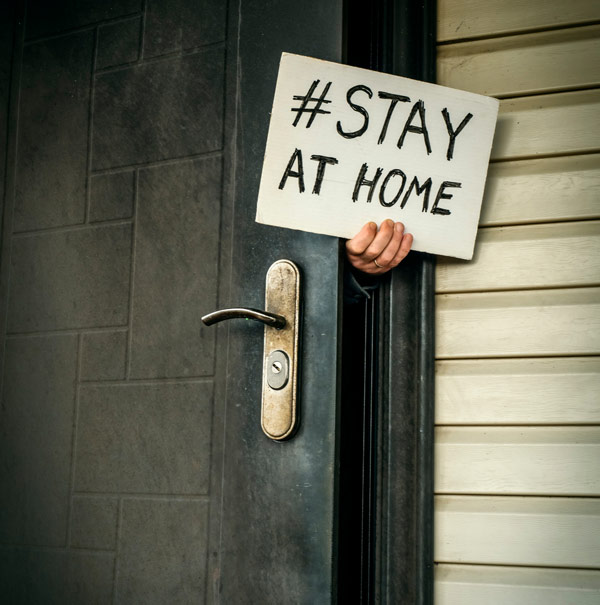“We need a spirit of community, a sense that we are all in this together. If we have no sense of community, the American dream will wither.” — William J. Clinton
World Gone Viral
2020 has been bizarre. A kind of liminality has descended on the world with two billion people locked down in limbo. Normal life has been suspended. Businesses and schools are closed, and our cities are ghost towns as people stay at home. You only have to look up at the sky. The absence of white contrails tells you lockdowns are global.
The word liminality comes from the Latin limen, which means “threshold.” The term was coined by social anthropologists to describe being in a transition from one stage of life to another—stages like pregnancy, puberty, coming of age, marriage, and death.
Social Separation
I wrote about liminality in “Liminal Thresholds: The Spaces Between,” and nothing illustrates the concept better than lives locked down under COVID-19. I lived in Hong Kong during the SARS outbreak in 2003. That, too, was a novel virus that killed one in ten it struck. But though it was lethal, SARS was nowhere as contagious as COVID-19. Some people wore masks, and most avoided public places. But we experienced no lockdowns. Businesses worked on, and our movements went unrestricted.
Recorded coronavirus infections already number in the millions, and governments have plunged us into a state of profound social and economic liminality in order to slow the pandemic. By that, I mean normal society and business are on hold. New directives mean we can’t interact with people as before. We must confine ourselves indoors, and when we venture outside for essentials, we have to keep our distance from each other.
Right of Passage
Liminal phases are more disruptive to normal life the longer they go on. And this brings insecurity because it evokes a sense of being betwixt and between—of lingering in a doorway between a vanished before and an unknown after.
Since early times, humans have paid attention to these “in-between” stages. We still mark them with rituals that foster a collective identity and mutual support to help those sharing the experience cope with the disorientation and anxiety brought on by their liminal state.
The coronavirus has disrupted twenty-first century society in ways our post-war generation could never imagine, and so it’s no surprise that a new ritual has swept the planet in the virus’s wake. From London to Paris, Istanbul to New York, communities emerge from their lockdowns to applaud their health workers. But this communal clapping, whooping, and banging of pans represent more than an outpouring of gratitude to those battling to save our lives. It is a collective act of civic solidarity that brings a sense of human connection and belonging at a time of social and national isolation.
United We Stand
According to Social Anthropologist, Victor Turner, liminality brings out a state he called communitas—a feeling of fellowship that emerges as people draw together for survival and mutual support in the face of adversity and uncertainty.
Social psychology professors Stephen Reicher and John Drury agree that collective participation enhances a community’s sense of togetherness, which encourages individuals to support and look out for each other. They write,
“Our own research on emergencies (Drury et al., 2019) shows that it is precisely when people stop thinking in terms of ‘I’ and start thinking in terms of ‘we’ – more technically, when they develop a sense of shared social identity – that they start to coordinate, support each-other and ensure that the neediest get the greatest help. Sometimes this sense of shared identity emerges by the very fact of experiencing a common threat. But messaging also matters. When a threat is framed in group rather than individual terms, the public response is more robust and more effective… The key issue is not so much ‘will I survive’ as ‘how do we get through it’.”
Frame of Mind
Liminality is a state of mind as much as a timespan. No one wants to stand on a threshold forever. We all want our normal lives back and the simple things we maybe took for granted…like the ability to get together with family and friends, and the freedom to work. As the seventeenth-century historian, Thomas Fuller, said, “We never know the worth of water till the well is dry.”
Truth is, COVID-19 is a viral force that’s here to stay. Life will be different from what we were used to—at least until testing, treatments, and vaccines enable us to beat it. In the meantime, communitas is our chief weapon. It underpins the mindset and values that lead us to react collectively in selfless ways for the benefit of the common good—such as social distancing and staying at home.
What’s important is our governments’ messaging and how they support us through this, both as individuals and as communities. After all, humans are social animals. It’s how we have evolved, and any form of social isolation and distancing is hard.
Professor Reicher recently tweeted that the public is making huge sacrifices, and governments must enable people to cope with the consequences, money-wise as well as psychologically. He also posted a link to the following article, which highlights research into the importance of shared identity and community:
Maintaining Lockdown and Preparing an Exit Strategy:
A View from Social and Behavioral Sciences
We should all take pride in how well the majority of the public has stuck with lockdowns. But as we gaze into a murky future and the economic consequences bite, governments should not take the spirit of communitas for granted. By and large, the public gets the risk. It wants to be safe, and the best way to do that is to keep us unified. That can last only as long as leaders keep our trust and provide us with the means to stay the course.

Stephen Chamberlain is the author of the fantasy novel Graëlfire. He draws inspiration from the impact of landscape on myth, and the association of liminality with the supernatural and magic. Stephen lives in Switzerland.



